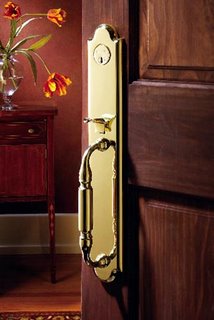Precedential No. 2: Finding Door Hardware and Toilets Related, TTAB cancels “DEVONSHIRE” Registration
In its second precedential decision of 2007, the Board granted a petition for cancellation of a registration for the mark DEVONSHIRE for “metal door hardware, namely, locks, latches and knobs," finding the mark likely to cause confusion with the identical mark previously used in connection with toilets and lavatories. Kohler Co. v. Baldwin Hardware Corp., 82 USPQ2d 1100 (TTAB 2007).

The Board first resolved several evidentiary disputes regarding admissibility of documents by way of notice of reliance, the business records exception to the hearsay rule, and the alleged failure to produce information and documents during discovery
Petitioner Kohler established priority of use via the detailed testimony of a single, very knowledgeable witness – its Director of Sanitary Marketing. Kohler proved use of the DEVONSHIRE mark as of late 1996; Respondent’s relied on the filing date of the application that issued as the challenged registration – December 11, 1997. The Board noted that “[o]ral testimony, even of a single witness, if ‘sufficiently probative,’ may be sufficient to prove priority.” Petitioner’s testimony carried with it “conviction of its accuracy and applicability,” and was buttressed by documentary evidence.
Turning to the issue of likelihood of confusion, the fact that the marks are identical heavily favored Kohler: when identical marks are involved the degree of similarity in the parties’ goods necessary to support a likelihood of confusion finding is diminished. Moreover, the Board found DEVONSHIRE to be a strong mark. With two strikes against it, Respondent Baldwin was clearly in deep trouble.

Baldwin argued that its mark is used only for expensive exterior door handle sets purchased only with “great care.” Unfortunately, the identification of goods in Baldwin’s registration contained no such restrictions. Thus the Board was required to assume that Baldwin’s goods included door hardware of all types, including “hardware for shower doors, bathroom doors, and bathroom cabinet doors.” Moreover, the Board found that the parties’ goods “may be viewed as complementary in that they may be used together; that is to say, some consumers, when buying a line of products for their bathroom, want their toilet, sink shower door, bathroom door and cabinet fixtures to all match or at least be coordinated.” Third-party registration evidence suggested that “toilets and sinks on the one hand, and door hardware on the other, are goods of a type that emanate from the same source.”
As to trade channels, the normal channels for the parties’ goods include home centers such as Home Depot. In fact, “the record established that the parties’ goods are sold in the exact same chain of stores, namely, Home Depot.” Although Kohler argued that the goods are sold in different departments, its identification of goods is broad enough to encompass bathroom hardware, which would likely be sold in the same department as toilets and lavatories. In addition, the parties’ goods have been shown at the same trade shows and in the same publications.
Baldwin attempted to establish widespread third-party use of DEVONSHIRE, but its unspecific evidence merited little weight. Baldwin also pointed to the lack of evidence of actual confusion despite six years of contemporaneous use of the parties’ marks. The Board was not swayed. It agreed with Kohler that the absence of actual confusion may reflect the fact that Baldwin has not actually used the mark on bathroom hardware, but only on expensive, external door hardware. Thus the Board concluded that there has been no meaningful opportunity for confusion to occur.
Balancing the relevant du Pont, the Board found that confusion is likely, and it granted the petition for cancellation.
TTABlog note: This decision bears the legend "THIS OPINION IS A PRECEDENT OF THE TTAB." Compare that to the first "citable" decision of 2007 (blogged here), which bore the legend "THIS DISPOSITION IS CITABLE AS PRECEDENT OF THE T.T.A.B." What's the difference? My guess is that the Board is anticipating the day when all of its decisions will be "citable," but not all will be precedential. So it's discontinuing use of the phrase "citable as precedent" lest one become confused. I guess it's time for me to switch from "citable" to "precedential" too.
BTW, one might ask, what's the point of a decision being citable if it's not precedential?
Text Copyright John L. Welch 2007.




0 Comments:
Post a Comment
<< Home